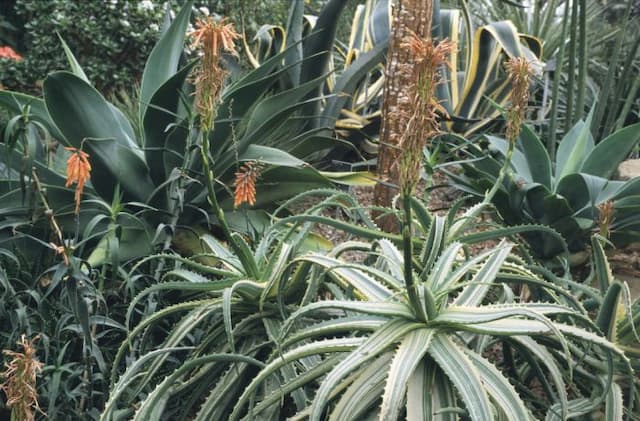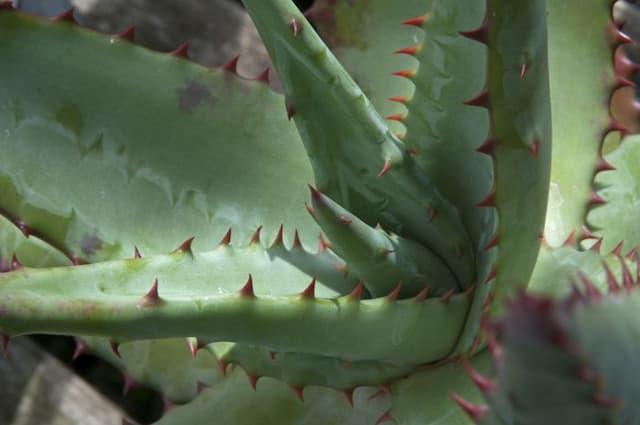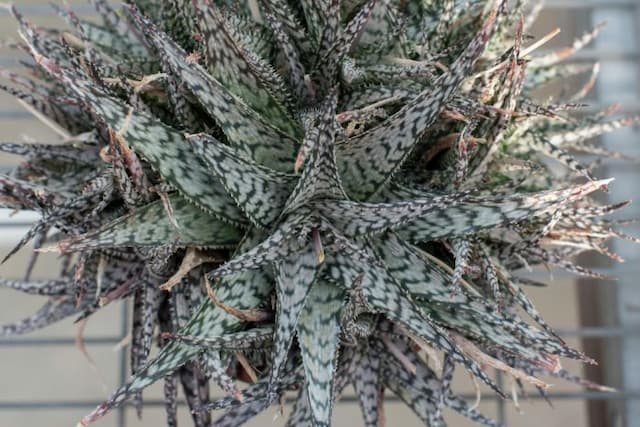Red Hot Poker Kniphofia 'Star of Baden-baden'

ABOUT
Kniphofia 'Star of Baden-Baden', commonly known as Red Hot Poker or Torch Lily, is a striking perennial known for its unique flowering spikes. The plant features a clump of narrow, grass-like leaves that create a dense tuft at the base. Rising from this foliage are the distinctive flower spikes, comprising a multitude of tubular flowers that are packed closely together in an elongated cluster. The blooms exhibit a gradient of colors, starting with a warm, fiery hue at the tip of the spike that can range from red to orange, which then transitions to a softer, yellowish tone toward the bottom. This creates a stunning, flame-like effect, which is particularly vibrant when multiple stems are in bloom simultaneously. The flowers are known to attract hummingbirds and a variety of pollinators, adding to the dynamic presence of this plant in the garden. The texture of the Red Hot Poker's leaves is somewhat coarse, providing a grassy, architectural backdrop that contrasts nicely with the smooth, waxy appearance of the flower spikes. This plant's distinctive look, characterized by the flaming coloration of its blooms and striking vertical lines, can make it a standout addition to any flower bed or border with its bold, eye-catching presence.
About this plant
 Names
NamesFamily
Asphodelaceae
Synonyms
Red Hot Poker, Torch Lily, Poker Plant, Tritoma
Common names
Kniphofia 'Star of Baden-baden'.
 Toxicity
ToxicityTo humans
Red hot poker (Kniphofia 'Star of Baden-baden') is not commonly known to be toxic to humans. If ingested, it is unlikely to cause serious harm or significant symptoms. However, as with many plants, it is possible for individuals to have mild allergic reactions or skin irritation from handling the plant without gloves. Ingesting significant amounts of the plant could potentially lead to stomach discomfort or other digestive issues simply due to the fact that it is not a food plant.
To pets
Red hot poker (Kniphofia 'Star of Baden-baden') is not commonly known to be toxic to pets. It is not typically listed as a plant that is dangerous if ingested by animals such as cats and dogs. However, consumption of non-food plants can sometimes lead to gastrointestinal upset in pets, so it is always best to prevent pets from eating ornamental plants. If a pet ingests a large amount of the plant and exhibits signs of distress or illness, it is advisable to consult a veterinarian. Symptoms, if any, could include vomiting or diarrhea due to the ingestion of non-food material.
 Characteristics
CharacteristicsLife cycle
Perennials
Foliage type
Evergreen
Color of leaves
Green
Flower color
Mixed
Height
3-4 feet (0.9-1.2 meters)
Spread
1-2 feet (0.3-0.6 meters)
Plant type
Herb
Hardiness zones
6
Native area
South Africa
Benefits
 General Benefits
General Benefits- Attracts pollinators: The vibrant flowers of Kniphofia, commonly known as Red Hot Poker, are known to attract bees, butterflies, and hummingbirds, providing a valuable source of nectar.
- Drought tolerance: Once established, Red Hot Poker plants are quite tolerant of drought, making them suitable for dry climates and water-wise gardens.
- Low maintenance: Red Hot Pokers typically require minimal care beyond the basic needs of water, sunlight, and occasional feeding, making them an easy option for gardeners of all levels.
- Long blooming period: With a flowering season that extends from late spring into summer, Red Hot Pokers offer a long-lasting display of color in the garden.
- Deer resistance: These plants are generally resistant to deer, making them an excellent choice for gardens that are prone to deer visits.
- Architectural interest: The striking vertical form and bold colors of Red Hot Poker flowers add visual interest and a touch of the exotic to garden landscapes.
- Versatility in landscaping: Kniphofia can be used in a variety of garden settings, including borders, beds, and container gardens, adding versatility to landscape design.
 Medical Properties
Medical PropertiesThis plant is not used for medical purposes.
 Air-purifying Qualities
Air-purifying QualitiesThis plant is not specifically known for air purifying qualities.
 Other Uses
Other Uses- Ecological Attraction: Red hot poker serves as a nectar source for hummingbirds and bees, helping to sustain local ecosystems.
- Garden Art: Due to its unique shape and color, red hot poker can be used as a natural sculpture element in garden design.
- Fabric Dye: The brightly colored flowers of the red hot poker can potentially be used in the production of natural dyes for fabrics.
- Erosion Control: With its clumping growth habit, red hot poker can help stabilize soil in areas prone to erosion.
- Feng Shui: Some may use red hot poker in their garden as a way to add 'fire' energy according to the principles of Feng Shui.
- Photography Subject: Due to its striking appearance, red hot poker is often chosen as a subject for botanical and garden photographers.
- Bird Sanctuary: The tall and dense foliage can provide shelter for small birds, making it a friendly addition to bird-friendly gardens.
- Border Planting: Red hot poker is suitable for creating dramatic borders along walkways or garden edges.
- Culinary Garnish: Although not commonly used, the flowers could be used as an exotic, edible garnish for certain dishes.
- Craft Materials: Dried flower spikes of red hot poker can be used in floral arrangements or as part of craft projects.
Interesting Facts
 Feng Shui
Feng ShuiRed Hot Poker is not used in Feng Shui practice.
 Zodiac Sign Compitability
Zodiac Sign CompitabilityRed Hot Poker is not used in astrology practice.
 Plant Symbolism
Plant Symbolism- Passion: Kniphofia, commonly known as Red Hot Poker, often symbolizes a strong emotion or enthusiasm due to its bold and striking fiery colors.
- Vibrancy: The vivid appearance of the Red Hot Poker embodies vibrancy and serves as a reminder to embrace life with zest and intensity.
- Attraction: With its bright flowers that stand out in the garden, the plant symbolizes attraction, suggesting that one can draw in others with their qualities or brightness.
- Standing Out: Red Hot Poker is symbolic of standing out in a crowd or being distinct, as its inflorescences rise above the foliage and catch the eye.
 Water
WaterRed hot pokers, including Kniphofia 'Star of Baden-Baden', should be watered regularly to maintain moist but not waterlogged soil, especially during their growing season in spring and summer. An approximate guideline is to provide about 1 inch of water weekly, which translates to roughly 0.6 gallons per square yard of garden area. During hot, dry spells, additional watering may be necessary to prevent the soil from drying out completely. Cut back on watering in the fall to help the plants harden off for winter, and during winter, water sparingly, only enough to prevent the soil from becoming completely dry.
 Light
LightRed hot pokers thrive in full sunlight, so placing Kniphofia 'Star of Baden-Baden' in a spot that receives at least 6 hours of direct sunlight per day is ideal. They can tolerate partial shade, but flowering may not be as prolific. The best spot will also be sheltered from strong winds, which can damage the tall flower spikes.
 Temperature
TemperatureRed hot pokers prefer a temperate climate and Kniphofia 'Star of Baden-Baden' is no exception. They are hardy in USDA zones 5 through 9, meaning they can survive temperatures down to -20°F and up to 90°F, though their ideal growing conditions are in temperatures between 50°F to 85°F. Avoid exposing them to temperatures outside this range for prolonged periods to prevent stress and damage.
 Pruning
PruningPruning red hot pokers, including Kniphofia 'Star of Baden-Baden', is mainly done to remove spent flower stalks and encourage a second bloom. Cut the flower spikes back to the base after flowering. Also, remove any damaged or dead foliage in the spring. Pruning can be done throughout the blooming season as necessary, typically from late spring to late summer, to keep the plant looking tidy.
 Cleaning
CleaningAs needed
 Soil
SoilRed hot poker prefers well-drained soil with a pH between 6.0 and 7.0. An ideal mix would be loamy soil with added compost and coarse sand to improve drainage. Avoid heavy, wet soils to prevent root rot.
 Repotting
RepottingRed hot poker is typically not repotted often as it is a perennial that can be left to grow in the same spot for several years. Repotting or dividing should occur only when the plant has outgrown its space, about every 3-5 years.
 Humidity & Misting
Humidity & MistingRed hot poker tolerates a wide range of humidity levels but doesn't require high humidity. Average outdoor humidity is generally sufficient for healthy growth.
 Suitable locations
Suitable locationsIndoor
Ensure full sun, use well-draining soil, and avoid overwatering.
Outdoor
Plant in full sun, well-draining soil, with space for air circulation.
Hardiness zone
6-9 USDA
 Life cycle
Life cycleThe Red Hot Poker 'Star of Baden-baden' begins its life cycle when a seed germinates in late spring or early summer, emerging as a small seedling with grass-like foliage. Over time, the seedling develops into a mature clump-forming perennial with long, slender leaves from which flower spikes emerge. In mid to late summer, the distinctive tall flower spikes bloom with vibrant tubular flowers, typically featuring a fiery gradient of red, orange, and yellow hues attracting pollinators such as hummingbirds and bees. After blooming, the flowers fade and seeds develop within the spent flower heads, which can be collected for propagation or left to self-sow. Throughout the fall and winter, the plant may become dormant, especially in cooler climates, with foliage dying back partially or completely. In the following spring, the Red Hot Poker's life cycle repeats, as new growth emerges and the plant prepares for another season of flowering.
 Propogation
PropogationPropogation time
Spring-Early Summer
The Kniphofia 'Star of Baden-baden', commonly known as Red Hot Poker or Torch Lily, can be propagated by dividing its clumps. The ideal time for division is in the spring after the danger of frost has passed, or early fall to allow enough time for the plants to settle before the onset of winter. To propagate by division, carefully dig up the established clump and use a sharp spade or knife to divide it into smaller sections, ensuring each section has at least one healthy shoot and a portion of the root system. Replant the divisions at the same depth they were originally growing, spacing them about 18 to 24 inches (approximately 45 to 60 centimeters) apart to allow for growth. Water the new plantings thoroughly to help establish them. Division helps to rejuvenate older clumps that may have become woody or less vigorous, encouraging more robust growth and flowering.









